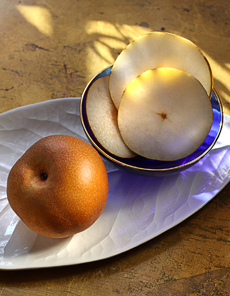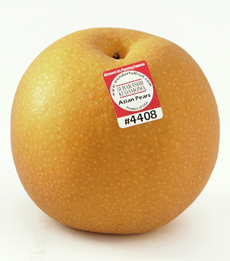TIP OF THE DAY: Asian Pears
|
In the spring, when the blossoms fall from the Asian pear trees, the nascent pears are the size of peas. Now, at harvest time, many are as large as croquet balls, some varieties the size of softballs (and yet low in calories—about 50 per 4 ounces).
If you see a red and white Subarashii Kudamono, the fruits haven’t crossed the Pacific Ocean: They’re grown in Pennsylvania. While on business in Japan in 1973, American inventor Joel Spira received a gift of Asian pears. Upon returning home, he tried to obtain more of the crunchy, juicy fruit but couldn’t find it. So, he decided to grow his own. Spira and his wife Ruth (who has a botany degree) purchased orchard land in the fertile Lehigh Valley of eastern Pennsylvania, and set about growing traditional varieties of Asian pears as well as creating new varieties. They named their company Subarashii Kudamono, Japanese for “wonderful fruit.” Today, thousands of their trees yield numerous varieties of Asian pears. The 2014 harvest has begun, and the fruit is now available at gourmet grocers from New York and New Jersey down to Pennsylvania, Maryland and Virginia, and nationally online at WonderfulFruit.com. |

A simple yet elegant dessert. Serve with an optional drizzle of honey. Photo courtesy WonderfulFruit.com. |
|
|
Asian pears are also grown in California, Oregon and Washington, in addition to orchards worldwide.
So today’s tip is to try Asian pears. ARE ASIAN PEARS PEARS, APPLES OR A HYBRID? “Asian pear” is the generic name for more than 25 different varieties of a pear species that originated in Asia. The fruit was first cultivated in what are now China, Japan and Korea, beginning as far back as 330 B.C.E. Although the shape is reminiscent of some varieties of apples and has the crunchy flesh of apples, the Asian pear, Pyrus pyrifolia, belongs to the same genus as European pears, Pyrus communis. This means you can eat them in the same way, in recipes or as hand fruit, with the skin or peeled. Don’t expect a creamy European pear texture, though, or any apple flavor from the fruit that is also known as apple pear, Korean pear, Chinese pear and sand pear, among other names. And unlike European pears, Asian pears don’t soften when ripe. They remain crunchy, even when cooked. This fruit is very versatile, pairing well (no pun intended) in savory and sweet recipes. For starters, consider: |
||
 If there’s no sticker, ask the produce manager about the variety and provenance of the Asian pears. Photo courtesy WonderfulFruit.com. |
RECIPE: SALAD WITH ASIAN PEARS You can turn this side salad into a main course by topping it with a grilled protein: chicken breast; fish fillet, scallops or shrimp; lamb, etc. Ingredients For 4 Servings |
|
|
Preparation 1. TEAR the radicchio into bite-sized pieces and combine with greens in a salad bowl (also tear greens if not using baby greens). Add the diced pears. 2. WHISK the vinegar and mustard, then whisk in the olive oil. Add honey, salt and pepper. Toss with the salad. 3. ADD cheese to top and serve. TRADITIONAL ASIAN PEAR VARIETIES Depending on the variety, Asian pears can range from medium to large to extra large. Most colors vary from yellow to tan-brown; some have green or russet hues. Their skin may be smooth or speckled. Some of the most popular varieties grown in the U.S. include Hosui (Golden Russet Brown), Kosui (Golden Russet), Nijiseiki or Twentieth Century (Yellow-Green), Shinseiki (Yellow) and Shinsui (Russet Brown). These conventional varieties are grown by Subarashii Kudamono: You can buy them online for yourself or as gifts. A 5-pound gift box is $29.95; a 9-pound gift box is $39.95. MORE ABOUT ASIAN PEARS.
|
||